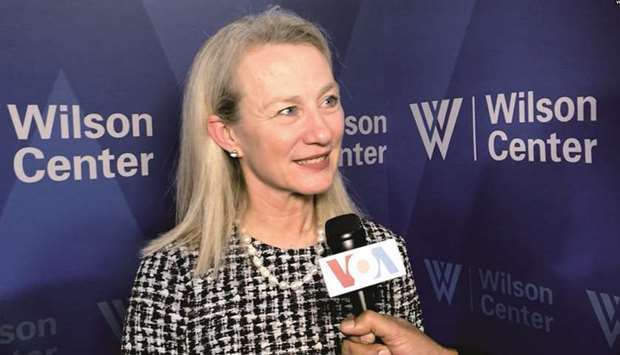When a $62bn project, rich in economic and infrastructural dividends, with a 3,000km network of railways, oil and gas pipelines, and renewable energy schemes connects two countries, some attention is only inevitable. On the flip side, it will invite the envy of those who will be hard-pressed to match it and therefore, unable to stomach it.
Early this week, it was evident in the unusually specific speech that Alice Wells, US Assistant Secretary of State for South and Central Asia, delivered on the subject at the Wilson Centre, a Washington think-tank before a host of diplomats, scholars and media persons where she basically warned that Pakistan was unwittingly priming to be at the receiving end of a Chinese juggernaut.
The China-Pakistan Economic Corridor — or CPEC as it is simply referred to — is the jewel in the crown of China’s ambitious Belt and Road Initiative (BRI) that involves partnering with dozens of countries around the world through trade and infrastructure projects such as shipping lanes, railroads and airports. A project as grandiose as BRI is not without its share of detractors and given the undercurrents of China’s rapidly expanding global reach and power was always bound to create unease for its rivals in the region and across the globe.
The top American diplomat for South Asia isn’t, of course, the first one to draw the red line on CPEC nor would likely be the last. However, her rather public and calibrated presentation is interesting for both its timing and a clear sense of desperation in Washington over its own considerably shrinking influence across the globe.
The timing is significant because a chastened US is attempting to revive ties with Pakistan after a long period of distrust and what is evidently the latest retreat to a historically transactional relationship. The Trump administration initially, disparaged Islamabad whilst vainly trying to secure a face-saving exit from Afghanistan after an 18-year-old draining war. It has since returned to siding with pragmatism, and only last week Trump called Prime Minister Imran Khan, with whom he has since built an equation, to thank him for the role Islamabad played in securing the release of two Western hostages, including an American, held by Taliban since 2016.
This is not to suggest that Wells did not raise pertinent posers, which would be par for the course in any project of this scale and, fundamentally speaking, economic sense. Two top ministers of Prime Minister Khan’s cabinet — Foreign Minister Shah Mehmood Qureshi and newly installed Minister for Planning and Development Asad Umar — quickly rebutted Wells’ argument that Islamabad was getting a raw deal from CPEC, which she claimed would push it to the edge in terms of a stifling debt and foster corruption whilst repatriating jobs and profits to China.
While Qureshi simply chose to reject Washington’s concerns as unfounded in a decidedly diplomatic mien, Umar held a presser to pointedly address the questions raised by the American diplomat whilst candidly agreeing that the questions were valid in certain respects but incorrectly posited for lack of intent or information. He spelt out, with facts and figures, how and why these fell short of passing muster.
Asserting that Islamabad would never back out of CPEC given its time-tested relationship with Beijing that had defied the odds since its inception, Umar said the country would never again become a “collateral damage” in a conflict between two major powers. While agreeing with Wells that the external debt had considerably impacted the economic progress over time, he dismissed the suggestion it was contrived by China.
“Our total public debt right now is $74bn, out of which the CPEC debt is $4.9bn — not even 10% of the total debt,” Umar pointed out. He also rejected the notion that it was a one-way street. “Both countries have benefited: Chinese firms got business as their machinery was exported to Pakistan. The lack of infrastructure in Pakistan, especially in the power sector, was where a lot of the country’s needs were met. Besides, CPEC became a source of financing in large amounts which was previously unavailable. So a base was laid out in the first phase and now further developments will take place in the next phase,” the minister explained.
Umar disclosed that special economic zones will be in business in about two months. While admitting that the first phase did not generate too many jobs, he explained it was important to understand that when the objective is infrastructural development, it happens. However, he expects once the industrial development takes off, it will line up jobs.
Meanwhile, Chinese ambassador to Pakistan Yao Jing expressed his “shock and surprise” at the US critique of CPEC, saying Washington should not be casting aspersions over something about which it does not have accurate information.
At a presser in Islamabad, he also countered why the US had suspended its promised aid to Pakistan (in 2018, the Trump administration suspended $2bn military aid, including what it owed to Islamabad as service charges for on ground assistance in the anti-terror war in Afghanistan) and not invested in its power sector despite knowing about the country’s dire shortfall.
“When in 2013, the Chinese companies were establishing power plants, where was the US,” he bristled. “If Pakistan was in need, China would never ask it to repay loans in time,” Ambassador Jing declared. He also dismissed Wells’ accusation of underwhelming Pakistani workforce, saying that 75,000 Pakistanis were employed in CPEC since 2015 — a number that he projected would grow to 2.3 million by 2030. In a parting shot, the envoy said he would be more than happy to see more investment coming from the US to Pakistan.
Reinforcing Islamabad’s position on the subject, Umar clarified the deep rooted ties with Beijing were not aimed against anyone. “We wish to have better relations with all countries. I can assure Alice Wells that American companies were welcome, are welcome and will continue to be welcomed to invest in Pakistan”.
* The writer is Features Editor. He tweets @kaamyabi

CRITIQUE: US Assistant Secretary of State for South and Central Asia Alice Wells made an unusually specific critique of the China-Pakistan Economic Corridor project at the Wilson Center in Washington DC earlier this week. (File photo)

